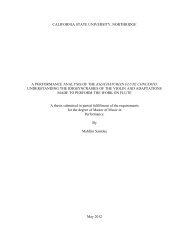2644 - CSUN ScholarWorks - California State University, Northridge
2644 - CSUN ScholarWorks - California State University, Northridge
2644 - CSUN ScholarWorks - California State University, Northridge
You also want an ePaper? Increase the reach of your titles
YUMPU automatically turns print PDFs into web optimized ePapers that Google loves.
2836<br />
journal of Student Research Abstracts · 85<br />
THE EFFECT OF liGHT ON THE GROWTH OF GERMAN IW.<br />
T.F. Jauregui and S. Engelmann (teacher). Palisades Charter High School, 15777 Bowdoin Street, Pacific<br />
Palisades, CA 90272.<br />
This experiment was used to observe the effect light has on the growth of German Ivy (Senecio mikanioides).<br />
Several3g specimens were placed in 2 different stations. One station allowed German Ivy to receive<br />
5 hours of light. The other station allowed only two hours of light. After 2 1/2 weeks their weight was recorded.<br />
The group that received 5 hours of light grew significantly more than the group with only 2 hours of light.<br />
My data shows that the quantity of light does affect the growth of German Ivy.<br />
2837<br />
THE EFFECTS OF WALL-SEEKING BEHAVIOR OF MICE.<br />
Stanley Lin and Steve DeGusta (teacher). John F. Kennedy High School, 6715 Gloria Drive, Sacramento,<br />
CA 95831.<br />
In this lab, the effects of light on the wall-seeking behavior of mice were studied. This behavior has been<br />
assumed by the general scientific community to be innate and stereotypical. By varying the environment of the<br />
mice, I tested to see whether or not this behavior is in fact innate, or just learned, that is, environmentally related.<br />
The test involved placing a mouse in a closed arena gridded into 64 squares. Each of the eight mice was<br />
tested under a bright light and a dim light. At three-second intervals for six minutes, tallies were made according<br />
to which squares the mice were in. The tallies showed that the mice's activity in squares adjacent to the<br />
walls decreased when the lighting was decreased, suggesting that light does have an effect on the behavior. The<br />
light was the environmental variable, which would suggest that environment does play a role in the behavior.<br />
The conclusion drawn was that the wall-seeking behavior is not innate, but rather is learned and is dependent<br />
on the environment. (p 0.1). Finally<br />
when I compared the 6-gallon tank to the 9-gallon tank, I was able to conclude that the larger tank showed the<br />
higher rate of growth in weight, but through statistics again my results were questionable (t = 2.040, 0.05 < p<br />













